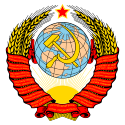- All-Russian Central Executive Committee
-
All-Russian Central Executive Committee (Всероссийский Центральный Исполнительный Комитет or ВЦИК, or, romanized, VTsIK), was the highest legislative, administrative, and revising body of the Russian Soviet Federative Socialist Republic. Although the All-Russian Congress of Soviets had supreme authority, in periods between its sessions its powers were passed to VTsIK. VTsIK functioned from 1917 until 1937.
Contents
Organization
By the Russian Constitution VTsIK was obligated to convene the All-Russian Congress of Soviets not less than twice a year (Statue 26 of Article XI). Extraordinary Congresses could be called whether from the initiative of VTsIK or on the request of local Soviets. The VTsIK was elected by the full Congress, with no more than 200 individuals. It was completely responsible to the Congress. The functions of the Collegiate or the Presidium were not declared in the Constitution but presumably they were supposed to be purely supervisory or revisionary bodies.
Provisions
VTsIK gave a general direction for the policies of the Workers-Peasant government and all bodies of the Soviet power in the country. It united and coordinated activities for legislation and administration as well as supervised the endorsement of the Soviet Constitution, declarations of the All-Russian Congress of Soviets and central bodies of the Soviet power. The All-Russian Central Executive Committee reviewed and adopted the projects of decrees and other propositions introduced by the Council of People's Commissars and separate departments as well as issued its own decrees and instructions. VTsIK convoked the All-Russian Congress of Soviets to which it presented the reports on its activity, general policy, and other inquiries. The All-Russian Central Executive Committee formed the Council of People's Commissars for general administrative affairs of the republic and departments (People's Commissariats) for the management of separate branches of administration. Members of VTsIK worked in the departments (People's Commissariats) or executed special assignments of the All-Russian Central Executive Committee.
Equally with the All-Russian Congress of Soviets VTsIK defined the State budget as well as budgets in different regions.
History
All-Russian Central Executive Committee was first elected at the first All-Russian Congress of Soviets in Petrograd, June 3–24, 1917. The first Central Executive Committee of the All-Russian Congress of Soviets was not a governing body and its chairman Nikolai Chkheidze was not the head of Russian state. This changed at the Second All-Russian Congress of Soviets during the October Revolution.
The Second All-Russian Congress of Soviets met in, and elected the second Central Executive Committee. This then became the executive body of the RSFSR.
It was composed of
- 62 Bolsheviks
- 29 Social Revolutionaries
- 10 Mensheviks
The first chairman of the CEC was Lev Kamenev, who directed the day to day work of the Committee. He only cast a vote if there was an even split in the committee.[1]
The full name at a one time was All-Russian Central Executive Committee of Workers', Peasants', Red Army, and Cossack Deputies (Всероссийский Центральный Исполнительный Комитет Советов рабочих, крестьянских, красноармейских и казачьих депутатов).
From the formation of the Soviet Union (1922), it downgraded from first (federal) level to second (federal-republic) level of governing body.
Following the adoption of the 1936 Soviet Constitution, this organ was replaced with the Supreme Soviet of the Russian SFSR.
Chairman of the Central Executive Committee of the RSFSR
- Lev Kamenev (November 9, 1917 - November 21, 1917)
- Yakov Sverdlov (November 21, 1917 - March 16, 1919) (died in office)
- Mikhail Vladimirsky (acting)(March 16, 1919 - March 30, 1919)
- Mikhail Kalinin (March 30, 1919 - July 15, 1938)
On December 30, 1922 the Soviet Union was formed. It comprised Soviet Russia (RSFSR) and other Communist-controlled Soviet republics. Mikhail Kalinin retained his position as Chairman of the Central Executive Committee of the All-Russian Congress of Soviets and became Chairman of the newly formed Central Executive Committee of the USSR as well. Both positions were mostly ceremonial, increasingly so in later years.
See also
References
- ^ Encyclopedia of Marxism: Glossary of Organisations accessed 7 August 2008
External links
Categories:- Government of the Soviet Union
- Historical legislatures
- History of the Soviet Union and Soviet Russia
- 1917 establishments in Russia
- 1938 disestablishments
Wikimedia Foundation. 2010.

